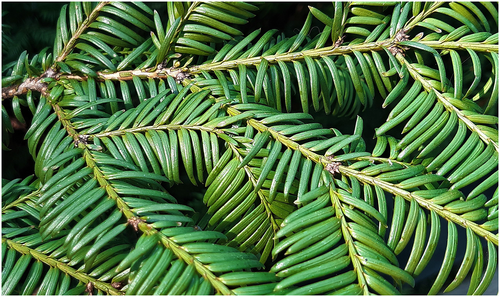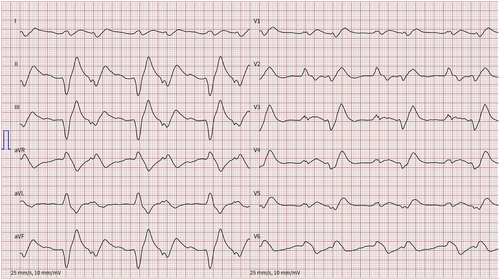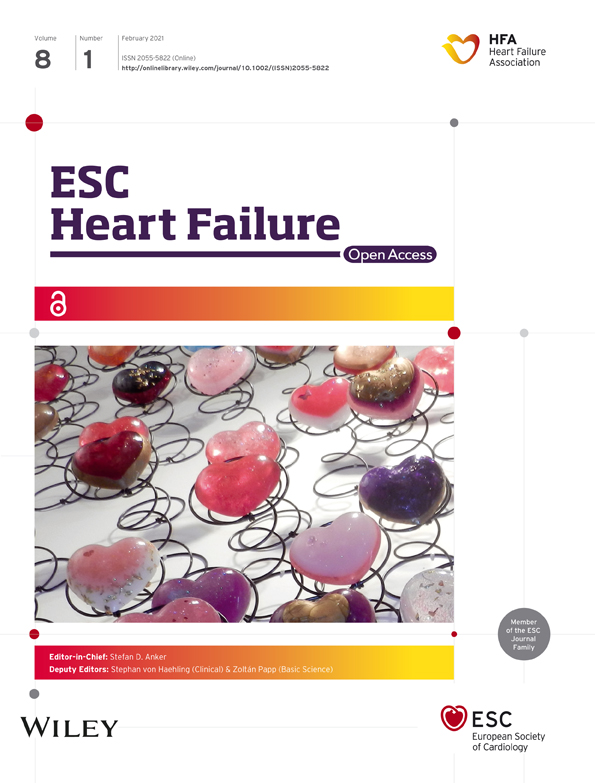Extracorporeal life support as bridge to recovery in yew poisoning: case reports and literature review
Abstract
Aims
This short communication aims to review the treatment of cardiogenic shock in patients with yew poisoning based on two case reports from our institution, focusing on the use of extracorporeal life support (ECLS).
Methods and results
We report two cases of Taxus baccata poisoning treated with ECLS at our institution and review the literature based on a search in PubMed and Google Scholar on the topic of yew poisoning and ECLS. All cases were combined for analysis of demographics, ECLS therapy, and outcome. Case 1: A 35-year-old woman developed polymorphic ventricular tachycardia followed by cardiovascular arrest 5 h after orally ingesting a handful of yew needles. Successful resuscitation required ECLS for 72 h due to ongoing cardiac arrhythmias and cardiogenic shock. The patient left the hospital without neurological sequelae after 10 days. Case 2: A 30-year-old woman developed refractory cardiac arrhythmias and circulatory arrest. Resuscitation included ECLS for 71 h. T. baccata needles found by gastroscopy confirmed the diagnosis. The patient had no neurologic deficits and was transferred to psychiatry after 11 days. Review of the literature: Nine case reports were found and analysed along with our two cases. Five out of the 11 (45%) patients were female. Median (range) age was 28 (19–46) years. T. baccata needles were ingested with a suicidal intention in all patients. Median (range) duration of ECLS was 70 h (24–120 h). Eight (73%) patients had full neurological recovery.
Conclusions
Yew poisoning is a differential diagnosis in young psychiatric patients presenting with polymorphic ventricular tachycardia and cardiogenic shock. A characteristic cardiac contraction pattern in echocardiography may present a diagnostic clue. The early use of ECLS is a valuable bridge to recovery in most of these patients.
Background
The common yew (Taxus baccata) is a conifer native to Europe (Figure 1). The wood, bark, needles, and seeds contain cardiotoxic alkaloids (taxines) in different concentrations. The ingestion of 50–100 g of needles may have a lethal effect.1 T. baccata poisoning is observed after accidental ingestion or attempted suicide. Clinical symptoms are caused by the blockade of cellular sodium and calcium channels and range from mild gastrointestinal symptoms to seizures, cardiac dysrhythmias, and cardiogenic shock.1, 2 Confirmation of Taxine B, 3,5-dimethoxyphenol (3,5-DMP), or other taxines in the blood serve as markers of ingestion.3

Aims
The aim of this report is to raise awareness of the early use of extracorporeal life support (ECLS) as a successful resuscitation measure in patients suffering from cardiogenic shock due to T. baccata poisoning.
Methods
We report two patients treated for T. baccata poisoning with ECLS at a tertiary hospital. Written informed consent was obtained from both patients. A literature search was conducted on PubMed and Google Scholar with the following criteria: ‘ECLS and Yew’, ‘ECMO and Yew’, ‘Taxus baccata and ECLS’, and ‘Taxus baccata and ECMO’. Eight case reports were found (PubMed, n = 5; Google Scholar, n = 3).4-11 A case report recently published in a Swiss medical journal was additionally included.12 All cases were combined for analysis of demographics, ECLS therapy, and outcome.
Results
Case 1
A 35-year-old female patient with a history of depression and suicidal attempts lost consciousness during family lunch. Her husband performed lay cardiopulmonary resuscitation (CPR) for 10 min, which was continued by professional CPR for another 20 min after the arrival of the emergency service. Return of spontaneous circulation was obtained after three defibrillation shocks (200 Joules), and administration of 4 mg epinephrine and 300 mg amiodarone intravenously (iv). Ventricular fibrillation (first rhythm) was changed to pulseless electrical activity and finally to a broad complex ventricular tachycardia (VT). During transport to the hospital, the blood pressure was stabilized with cumulative 1 mg of epinephrine. In the emergency department, VT (Figure 2) persisted. Transthoracic echocardiography (TTE) showed a desynchronized, ‘vermicular’-like ventricular contraction pattern with a severely reduced ejection fraction (EF). Owing to progression of the cardiogenic shock, an ECLS system (Maquet Cardiohelp; bi-femoral veno-arterial cannulation; venous cannula 25 French, arterial cannula 17 French; initial blood flow 4.3 L/min) was implanted 2.5 h after symptoms onset. Three cardioversion shocks (200 Joules) and 100 mg lidocaine iv did not convert the VT. Coronary artery disease was excluded by coronary angiography, and the patient admitted to the intensive care unit (ICU). Meanwhile, the husband found recent search activity regarding ‘yew poisoning’ on the patient's mobile phone. Therefore, 7 h after symptoms onset, activated charcoal (65 g) was administered via a nasogastric tube (NT) and 100 mL sodium bicarbonate 8.4% iv (pH goal 7.45–7.5). Two hours later, the electrocardiogram (ECG) demonstrated a normal sinus rhythm without conduction blocks. Yew poisoning was confirmed by liquid chromatography coupled with mass spectrometry, showing the presence of Taxine B and Isotaxine B in the blood. The following day, a TTE showed a mildly reduced left ventricular (LV) and a normal right ventricular function. Following the administration of levosimendan, the ECLS was weaned and explanted after 72 h. A cannula-related stenosis of the external iliac artery was stented. The patient woke up with fine motor skill disturbances, which completely resolved over time. She admitted to having ingested a handful of yew needles in a suicidal intention approximately 5 h prior to her loss of consciousness. The patient was discharged from the hospital with a normal heart function after 10 days.

Case 2
A 30-year-old female patient with a history of recurrent depression was referred from a psychiatric institution, after a non-observed collapse with a bleeding wound on her forehead. After arrival of the emergency service, three generalized tonic–clonic seizures were terminated by midazolam iv. During the transport to the hospital, she suffered from nausea and vomiting. In the emergency department, her clinical state deteriorated. The ECG showed an alternating broad complex tachycardia and bradycardia with recurrent episodes of asystole (up to 45 s). A focused TTE demonstrated spiral ‘vermicular’ movements of the LV myocardium and a severely reduced EF. The patient lost consciousness, and CPR was immediately initiated. She was defibrillated four times and received cumulatively 6 mg adrenaline, 300 mg amiodarone, 16 mmol magnesium chloride, and 1.5 mg atropine without heart rhythm stabilization. Because of her age, low cardiovascular risk profile and, the erratic nature of the arrhythmia, coronary ischaemia seemed unlikely to cause the cardiac arrest. Based on the psychiatric history, ECG morphology, and TTE myocardial contraction pattern, a suicide attempt with antidepressant drugs, digitalis or yew, was suspected. To stabilize the patient haemodynamically, an ECLS system (Maquet Cardiohelp, cannulation site and material as in Case 1, initial blood flow 4.5 L/min) was implanted under CPR (total duration 60 min) 2 h after symptoms onset; 400 mg digoxin antibodies (fab fragments) and 200 mL sodium bicarbonate 8.4% were administered iv. Two hours later, a large quantity of tree needles macroscopically compatible with yew was found and evacuated by gastroscopy from the patient's stomach. Activated charcoal (75 g) was administered via a NT. After exclusion of intracranial lesions by a computed tomography scan, the patient was admitted to the ICU. Six hours later, the ECG showed a regular sinus rhythm without conduction blocks. Laboratory blood analysis confirmed the presence of Taxine B. The following day, a TTE presented a normal heart function. The ECLS was weaned and explanted after 71 h. Due to the emergent ECLS implantation, the femoral artery had to be surgically reconstructed bilaterally. The patient woke up in a psychotic mental state. Magnetic resonance imaging ruled out ischaemic brain injury. After treatment with antipsychotics, the patient mentally recovered and confirmed the ingestion of yew needles in a suicidal attempt. The patient was referred to psychiatry after 11 days.
Review of the literature
The literature search revealed nine case reports of patients treated with ECLS for yew intoxication between 2010 and 2019.4-12 With our two cases, a total of 11 patients were analysed. Patient characteristics are summarized in Table 1. Five out of 11 (45%) patients were female. The median age was 28 years (range 19–46 years). T. baccata needles were orally ingested with a suicidal intention in all patients. The median ECLS duration was 70 h (range 24–120 h). Five (45%) patients received anti-digoxin antibodies (fab fragments),5, 7-9 and two (18%) patients therapeutic hypothermia.7, 8 Eight (73%) patients completely recovered,5-8, 10, 11 two (18%) patients died,4, 12 and one patient was bedridden due to post-hypoxic encephalopathy.9
| Patients/references | Year | Age (years) | Gender | ECLS duration (hours) | Therapeutic hypothermia | Administration of digoxin fab fragment | Outcome |
|---|---|---|---|---|---|---|---|
| Case 1 | 2019 | 35 | Female | 72 | No | No | Recovery |
| Case 2 | 2019 | 30 | Female | 71 | No | Yes | Recovery |
| Ref 12 | 2019 | 20 | Male | 24 | No | No | Brain death |
| Ref 4 | 2019 | 25 | Male | 96 | No | No | Brain death |
| Ref 5 | 2017 | 20 | Female | 120 | No | Yes | Recovery |
| Ref 6 | 2017 | 28 | Male | 48 | No | No | Recovery |
| Ref 7 | 2015 | 24 | Female | 70 | Yes | Yes | Recovery |
| Ref 8 | 2014 | 19 | Female | 36 | Yes | Yes | Recovery |
| Ref 9 | 2014 | 39 | Male | 24 | No | Yes | Encephalopathy |
| Ref 10 | 2011 | 46 | Male | 50 | No | No | Recovery |
| Ref 11 | 2010 | 44 | Male | 72 | No | No | Recovery |
Discussion
We report the successful resuscitation with ECLS of two patients in cardiac arrest due to yew (T. baccata) poisoning. The psychiatric history, an ECG with polymorphic/bimorphic ventricular brady-tachyarrhythmia, and a TTE with characteristic LV contraction pattern raised the suspicion of yew poisoning. The presence of yew needles in the stomach and taxines in the blood confirmed the diagnosis. In all cases, yew poisoning occurred in young patients with a suicidal intention.
Along with gastroscopy and charcoal administration, multiple measures are used to limit the toxicity of T. baccata.2 A particular problem is the poor response of associated arrhythmias and cardiogenic shock to atropine,5, 13 external/internal pacing14, 15 or catecholamines,5, 7, 13 intravenous administration of lidocaine,16 and sodium bicarbonate.17, 18 Few case reports attribute beneficial effects to digoxin-specific antibodies (fab fragment).5, 19 Because taxines are lipophilic compounds, intravenous lipid emulsion (ILE) may be considered for their removal.20, 21 Noticeably, the use of ILE by itself has been associated with severe side effects: acute kidney and lung injury, venous thromboembolism, hypersensitivity, and fat overload syndrome have been described.22 Caution is advised if ILE is to be used in a patient on ECLS because blood clot formation in the circuit and malfunction of the membrane oxygenator due to fat emulsion agglutinations have been reported.23 In our opinion, ILE treatment may be used in poisoned patients with cardiogenic shock only if ECLS is not readily available or no option.
ECLS may be used as a bridge to recovery, bridge to decision, bridge to bridge, or bridge to transplantation.24 Its increasing use engenders morbidity and mortality.25 Complications include vascular injury, bleeding, neurological adverse effects, and infection.26 In yew poisoning, ECLS supports the circulation during cardiac arrhythmias and/or failure. The biological half-life of taxine metabolites ranges between 11 and 13 h.27 Therefore, ECLS explantation can be accomplished in less than 72 h in most patients, as cardiac function recovers when the taxines are cleared from the patient's blood. Timely transfer to a tertiary care centre with an ECLS program is highly recommended for patients with suggested reversible causes of cardiogenic shock like yew poising. According to the available literature, the outcome of patients with yew poisoning on ECLS appears to be excellent if ECLS implantation is preceded by optimal CPR.
Conclusions
Yew poisoning is a differential diagnosis in young psychiatric patients presenting with polymorphic ventricular tachyarrhythmias, characteristic echocardiography findings, and cardiogenic shock. The diagnosis is confirmed by the presence of yew needles in the patient's stomach and/or laboratory evidence of typical toxins in the blood. The early use of ECLS is a valuable bridge to recovery in most of these patients.
Conflict of interest
Julia Hermes-Laufer, Martin Meyer, Alain Rudiger, Julian Henze, Kai Enselmann, Hugo Kupferschmidt, Daniel Müller, Aline Herzog, Dominique Bettex, Dagmar Keller Lang, Bernard Krüger, and Judith Engeler declare that they have no conflict of interest.
Funding
This work received no financial support.




